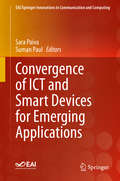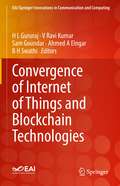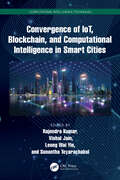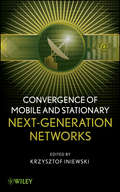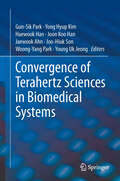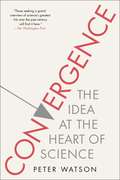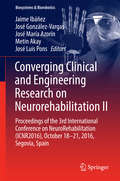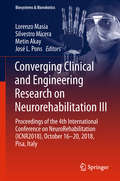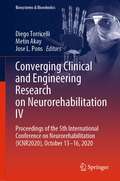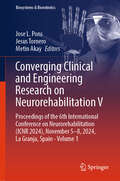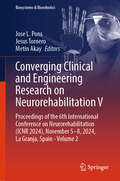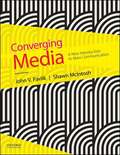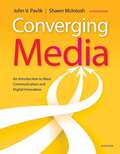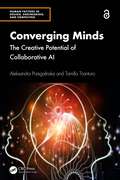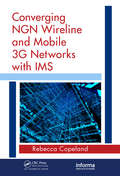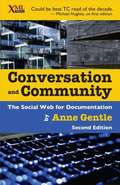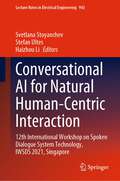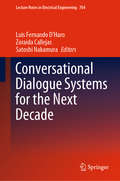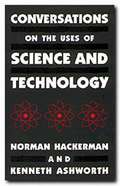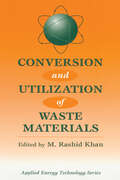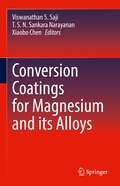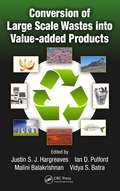- Table View
- List View
Convergence of ICT and Smart Devices for Emerging Applications (EAI/Springer Innovations in Communication and Computing)
by Sara Paiva Suman PaulThis book focuses on recent topics related to the convergence of information and communication technologies (ICT) and computing with smart devices. Domain areas of application include social, industrial, business development, and day to day life aspects. This book presents chapters related to the aforementioned topics including case studies showcasing future technological trends and challenges. Topics social inclusion solutions and social changes; smart devices and applications for day to day life; smart IoT and applications; and smart cities solutions. The book is applicable to researchers, students, professionals, and professors in a wide range of fields.Focuses on recent developments in ICT and smart devices that pose a clear benefit for users;Presents applications of ICT in education, health, electronics, communication, networking, computing, tourism, transportation;Appeals to researchers, academics, and professionals in a cross section of disciplines.
Convergence of Internet of Things and Blockchain Technologies (EAI/Springer Innovations in Communication and Computing)
by Sam Goundar H L Gururaj V Ravi Kumar Ahmed A Elngar B H SwathiThis book presents chapters from diverse range of authors on different aspects of how Blockchain and IoT are converging and the impacts of these developments. The book provides an extensive cross-sectional and multi-disciplinary look into this trend and how it affects artificial intelligence, cyber-physical systems, and robotics with a look at applications in aerospace, agriculture, automotive, critical infrastructures, healthcare, manufacturing, retail, smart transport systems, smart cities, and smart healthcare. Cases include the impact of Blockchain for IoT Security; decentralized access control systems in IoT; Blockchain architecture for scalable access management in IoT; smart and sustainable IoT applications incorporating Blockchain, and more. The book presents contributions from international academics, researchers, and practitioners from diverse perspectives.Presents how Blockchain and IoT are converging and the impacts of these developments on technology and its application;Discusses IoT and Blockchain from cross-sectional and multi-disciplinary perspectives;Includes contributions from researchers, academics, and professionals from around the world.
Convergence of IoT, Blockchain, and Computational Intelligence in Smart Cities (Computational Intelligence Techniques)
by Rajendra Kumar Vishal Jain Leong Wai Yie Sunantha TeyarachakulThis edited book presents an insight for modelling, procuring, and building the smart city plan using the Internet of Things (IoT) and a security framework using blockchain technology. The applications of Li-Fi and 5G in smart cities are included, along with their implementation, challenges, and advantages. This book focuses on the use of IoT and blockchain in the day-to-day transparent and recorded activities of citizens of smart cities like, smart citizen management. The future for upgrading the system as per technological advancements is also discussed. This book: integrates IoT, blockchain, Li-Fi, and 5G in smart city implementation covers smart supply chain management using IoT outlines the state-of-the-art and sustainable implementation of smart cities and practical challenges includes sustainable development of smart cities presents detailed explanation of case studies of smart cities of developed countries and developing countries and their comparisons This book is aimed at researchers and graduate students in Artificial Intelligence, Urban Planning, and Information Technology Systems and Management.
Convergence of Mobile and Stationary Next-Generation Networks
by Krzysztof IniewskiThe Only Resource to Cover Wireless, Wireline, and Optical Networks in One VolumeMobile and stationary next-generation networks that access the photonic core are destined to become as ubiquitous as traditional telephone networks. These networks must efficiently provide adequate network quality to multimedia applications with high bandwidth and strict quality-of-service requirements, as well as seamlessly integrate mobile and fixed architectures. Today's engineering students must be properly prepared to meet the challenges of next-generation network development and deployment.Featuring contributions from top industrial experts and academic professors, this authoritative work provides a comprehensive introduction to next-generation networks. It explains wireless networks such as wireless local area networks (WLAN), wireless personal area networks (WPAN), wireless access, 3G/4G cellular, and RF transmission, as well as optical networks like long-haul and metropolitan networks, optical fiber, photonic devices, and VLSI chips. Rather than focusing on heavy math or physical details, this resource explores how the technology is being used. It describes access and transport network layer technologies while also discussing the network and services aspects.Chapter coverage includes:Fiber-wireless networks: technologies, architectures, and future challengesPacket backhaul networkPoint-to-point microwave backhaulFourth-generation broadband: paving the road to Gbit/s with copperDynamic bandwidth allocation in EPON and GPONNext-generation ethernet passive optical networks: 10G-EPONPower line communications and smart gridsSignaling for multimedia conferencing in 4G: architecture, evaluation, and issuesSelf-coexistence and security in cognitive radio networksMobile WiMAXUWB personal area networks--MIMO extensionsNext-generation integrated metropolitan-access network: technology integration and wireless convergenceResilient burst ring: a novel technology for the next-generation metropolitan area networksFilled with illustrations and practical examples from industry, this book will be invaluable to engineers and researchers in industry and academia, as well as senior undergraduate and graduate students, marketing and management staff, photonics physicists, and chip designers.
Convergence of Telecommunications and Broadcasting in Japan, United Kingdom and Germany: Technological Change, Public Policy and Market Structure
by Koichiro Agata Kiyoshi NakamuraThe convergence of telecommunications and broadcasting raises many questions. What form will convergence take in the future? When convergence produces new opportunities in the information, education and entertainment markets, what sort of rules of the game will be required? How will the players behave in these new markets? What policies might be needed?
Convergence of Terahertz Sciences in Biomedical Systems
by Gun-Sik Park Haewook Han Jaewook Ahn Joo-Hiuk Son Joon Koo Han Woong-Yang Park Yong Hyup Kim Young Uk JeongRecent technological breakthrough in the field of Terahertz radiation has triggered new applications in biology and biomedicine. Particularly, biological applications are based on the specific spectroscopic fingerprints of biological matter in this spectral region. Historically with the discovery of new electromagnetic wave spectrum, we have always discovered new medical diagnostic imaging systems. The use of terahertz wave was not realized due to the absence of useful terahertz sources. Now after successful generation of THz waves, it is reported that a great potential for THz wave exists for its resonance with bio-molecules. There are many challenging issues such as development of THz passive and active instrumentations, understanding of THz-Bio interaction for THz spectroscopy, THz-Bio nonlinear phenomena and safety guideline, and THz imaging systems. Eventually the deeper understanding of THz-Bio interaction and novel THz systems enable us to develop powerful THz biomedical imaging systems which can contribute to biomedical industry. This is a truly interdisciplinary field and convergence technology where the communication between different disciplines is the most challenging issue for the success of the great works. One of the first steps to promote the communications in this convergence technology would be teaching the basics of these different fields to the researchers in a plain language with the help of Convergence of Terahertz Science in Biomedical Systems which is considered to be 3-4th year college students or beginning level of graduate students. Therefore, this type of book can be used by many people who want to enter or understand this field. Even more it can be used for teaching in universities or research institutions.
Convergence: The Idea at the Heart of Science
by Peter WatsonA brilliant history of science over the past 150 years that offers a powerful new argument—that the many disparate scientific branches are converging on the same truths.Convergence is a history of modern science with an original and significant twist. Various scientific disciplines, despite their very different beginnings, have been coming together over the past 150 years, converging and coalescing. Intimate connections have been discovered between physics and chemistry, psychology and biology, genetics and linguistics. In this groundbreaking book, Peter Watson identifies one extraordinary master narrative, capturing how the sciences are slowly resolving into one overwhelming, interlocking story about the universe. Watson begins his narrative in the 1850s, the decade when, he argues, the convergence of the sciences began. The idea of the conservation of energy was introduced in this decade, as was Darwin’s theory of evolution—both of which rocketed the sciences forward and revealed unimagined interconnections and overlaps between disciplines. The story then proceeds from each major breakthrough and major scientist to the next, leaping between fields and linking them together. Decade after decade, the story captures every major scientific advance en route to the present, proceeding like a cosmic detective story, or the world’s most massive code-breaking effort. Watson’s is a thrilling new approach to the history of science, revealing how each piece falls into place, and how each uncovers an “emerging order.” Convergence is, as Nobel Prize-winning physicist Steven Weinberg has put it, “The deepest thing about the universe.” And Watson’s comprehensive and eye-opening book argues that all our scientific efforts are indeed approaching unity. Told through the eyes of the scientists themselves, charting each discovery and breakthrough, it is a gripping way to learn what we now know about the universe and where our inquiries are heading.
Converging Clinical and Engineering Research on Neurorehabilitation II: Proceedings of the 3rd International Conference on NeuroRehabilitation (ICNR2016), October 18-21, 2016, Segovia, Spain (Biosystems & Biorobotics #15)
by Metin Akay José González-Vargas Jaime Ibáñez José Luis Pons José María AzorínThe book reports on advanced topics in the areas of neurorehabilitation research and practice. It focuses on new methods for interfacing the human nervous system with electronic and mechatronic systems to restore or compensate impaired neural functions. Importantly, the book merges different perspectives, such as the clinical, neurophysiological, and bioengineering ones, to promote, feed and encourage collaborations between clinicians, neuroscientists and engineers. Based on the 2016 International Conference on Neurorehabilitation (ICNR 2016) held on October 18-21, 2016, in Segovia, Spain, this book covers various aspects of neurorehabilitation research and practice, including new insights into biomechanics, brain physiology, neuroplasticity, and brain damages and diseases, as well as innovative methods and technologies for studying and/or recovering brain function, from data mining to interface technologies and neuroprosthetics. In this way, it offers a concise, yet comprehensive reference guide to neurosurgeons, rehabilitation physicians, neurologists, and bioengineers. Moreover, by highlighting current challenges in understanding brain diseases as well as in the available technologies and their implementation, the book is also expected to foster new collaborations between the different groups, thus stimulating new ideas and research directions.
Converging Clinical and Engineering Research on Neurorehabilitation III: Proceedings of the 4th International Conference on NeuroRehabilitation (ICNR2018), October 16-20, 2018, Pisa, Italy (Biosystems & Biorobotics #21)
by Metin Akay José L. Pons Lorenzo Masia Silvestro MiceraThe book reports on advanced topics in the areas of neurorehabilitation research and practice. It focuses on new methods for interfacing the human nervous system with electronic and mechatronic systems to restore or compensate impaired neural functions. Importantly, the book merges different perspectives, such as the clinical, neurophysiological, and bioengineering ones, to promote, feed and encourage collaborations between clinicians, neuroscientists and engineers. Based on the 2018 International Conference on Neurorehabilitation (ICNR 2018) held on October 16-20, 2018, in Pisa, Italy,, this book covers various aspects of neurorehabilitation research and practice, including new insights into biomechanics, brain physiology, neuroplasticity, and brain damages and diseases, as well as innovative methods and technologies for studying and/or recovering brain function, from data mining to interface technologies and neuroprosthetics. In this way, it offers a concise, yet comprehensive reference guide to neurosurgeons, rehabilitation physicians, neurologists, and bioengineers. Moreover, by highlighting current challenges in understanding brain diseases as well as in the available technologies and their implementation, the book is also expected to foster new collaborations between the different groups, thus stimulating new ideas and research directions.
Converging Clinical and Engineering Research on Neurorehabilitation IV: Proceedings of the 5th International Conference on Neurorehabilitation (ICNR2020), October 13–16, 2020 (Biosystems & Biorobotics #28)
by Metin Akay Diego Torricelli Jose L. PonsThe book reports on advanced topics in the areas of neurorehabilitation research and practice. It focuses on new methods for interfacing the human nervous system with electronic and mechatronic systems to restore or compensate impaired neural functions. Importantly, the book merges different perspectives, such as the clinical, neurophysiological, and bioengineering ones, to promote, feed and encourage collaborations between clinicians, neuroscientists and engineers. Based on the 2020 International Conference on Neurorehabilitation (ICNR 2020) held online on October 13-16, 2020, this book covers various aspects of neurorehabilitation research and practice, including new insights into biomechanics, brain physiology, neuroplasticity, and brain damages and diseases, as well as innovative methods and technologies for studying and/or recovering brain function, from data mining to interface technologies and neuroprosthetics. In this way, it offers a concise, yet comprehensive reference guide to neurosurgeons, rehabilitation physicians, neurologists, and bioengineers. Moreover, by highlighting current challenges in understanding brain diseases as well as in the available technologies and their implementation, the book is also expected to foster new collaborations between the different groups, thus stimulating new ideas and research directions.
Converging Clinical and Engineering Research on Neurorehabilitation V: Proceedings of the 6th International Conference on Neurorehabilitation (ICNR 2024), November 5–8, 2024, La Granja, Spain - Volume 1 (Biosystems & Biorobotics #31)
by Metin Akay Jose L. Pons Jesus TorneroThe book reports on advanced topics in the areas of neurorehabilitation research and practice. It focuses on new methods for interfacing the human nervous system with electronic and mechatronic systems to restore or compensate impaired neural functions. Importantly, the book merges different perspectives, such as the clinical, neurophysiological, and bioengineering ones, to promote, feed and encourage collaborations between clinicians, neuroscientists and engineers. Based on the 2024 International Conference on Neurorehabilitation (ICNR2024) held in La Granja, Spain on November 5-8, 2024, this book covers various aspects of neurorehabilitation research and practice, including new insights into biomechanics, brain physiology, neuroplasticity, and brain damages and diseases, as well as innovative methods and technologies for studying and/or recovering brain function, from data mining to interface technologies and neuroprosthetics. In this way, it offers a concise, yet comprehensive reference guide to neurosurgeons, rehabilitation physicians, neurologists, and bioengineers. Moreover, by highlighting current challenges in understanding brain diseases as well as in the available technologies and their implementation, the book is also expected to foster new collaborations between the different groups, thus stimulating new ideas and research directions.
Converging Clinical and Engineering Research on Neurorehabilitation V: Proceedings of the 6th International Conference on Neurorehabilitation (ICNR 2024), November 5–8, 2024, La Granja, Spain - Volume 2 (Biosystems & Biorobotics #32)
by Metin Akay Jose L. Pons Jesus TorneroThe book reports on advanced topics in the areas of neurorehabilitation research and practice. It focuses on new methods for interfacing the human nervous system with electronic and mechatronic systems to restore or compensate impaired neural functions. Importantly, the book merges different perspectives, such as the clinical, neurophysiological, and bioengineering ones, to promote, feed and encourage collaborations between clinicians, neuroscientists and engineers. Based on the 2024 International Conference on Neurorehabilitation (ICNR2024) held in La Granja, Spain on November 5-8, 2024, this book covers various aspects of neurorehabilitation research and practice, including new insights into biomechanics, brain physiology, neuroplasticity, and brain damages and diseases, as well as innovative methods and technologies for studying and/or recovering brain function, from data mining to interface technologies and neuroprosthetics. In this way, it offers a concise, yet comprehensive reference guide to neurosurgeons, rehabilitation physicians, neurologists, and bioengineers. Moreover, by highlighting current challenges in understanding brain diseases as well as in the available technologies and their implementation, the book is also expected to foster new collaborations between the different groups, thus stimulating new ideas and research directions.
Converging Media
by John V. Pavlik Shawn McIntoshIndustry. Culture. Technology. It's time they came together. From reading news on tablets to video calling on smartphones, digital media has changed the ways in which we communicate. Placing convergence at the center of the discussion, Converging Media: A New Introduction to Mass Communication, Sixth Edition, uses the technologies we employ every day to explain our current media environment--and to consider where we might be headed.
Converging Media: An Introduction To Mass Communication And Digital Innovation
by Shawn McIntosh John PavlikIndustry. Culture. Technology. They have come together. What's next? From reading news on tablets to video calling on smartphones, digital media has changed the ways in which we communicate. Placing convergence at the center of the discussion, Converging Media: An Introduction to Mass Communication, Seventh Edition, uses the technologies we employ every day to explain our current media environment-and to consider where we might be headed.
Converging Minds: The Creative Potential of Collaborative AI (Human Factors in Design, Engineering, and Computing)
by Aleksandra Przegalinska Tamilla TriantoroThis groundbreaking book explores the power of collaborative AI in amplifying human creativity and expertise. Written by two seasoned experts in data analytics, AI, and machine learning, the book offers a comprehensive overview of the creative process behind AI-powered content generation. It takes the reader through a unique collaborative process between human authors and various AI-based topic experts, created, prompted, and fine-tuned by the authors.This book features a comprehensive list of prompts that readers can use to create their own ChatGPT-powered topic experts. By following these expertly crafted prompts, individuals and businesses alike can harness the power of AI, tailoring it to their specific needs and fostering a fruitful collaboration between humans and machines. With real-world use cases and deep insights into the foundations of generative AI, the book showcases how humans and machines can work together to achieve better business outcomes and tackle complex challenges. Social and ethical implications of collaborative AI are covered and how it may impact the future of work and employment. Through reading the book, readers will gain a deep understanding of the latest advancements in AI and how they can shape our world.Converging Minds: The Creative Potential of Collaborative AI is essential reading for anyone interested in the transformative potential of AI-powered content generation and human-AI collaboration. It will appeal to data scientists, machine learning architects, prompt engineers, general computer scientists, and engineers in the fields of generative AI and deep learning.Chapter 1 of this book is freely available as a downloadable Open Access PDF at http://www.taylorfrancis.com under a Creative Commons [Attribution- No Derivatives (CC-BY -ND)] 4.0 license.
Converging NGN Wireline and Mobile 3G Networks with IMS: Converging NGN and 3G Mobile
by Rebecca CopelandFocusing on the future network architecture and its main principles, Converging NGN Wireline and Mobile 3G Networks with IMS provides a comprehensive view of the methods, functions, network elements, and the interfaces among them that enable the building of a service agnostic and access agnostic session control layer based on the IMS standar
Conversation and Community
by Anne GentleAnne Gentle's Conversation and Community has become the go-to reference for social media and technical communication. Her clear-eyed survey of the social media landscape has been adopted by many universities and is widely used by technical communicators. Now, in this second edition, she has updated and expanded her book, adding chapters on building a content strategy, analyzing web techniques, and developing an open source strategy. With more interviews and case studies, this is your guide to the new world of technical communication and social media. Inside the Book Towards the Future of Documentation Defining a Writer's Role with the Social Web Community and Documentation Commenting and Connecting with Users Wikis as Documentation Systems Finding Your Voice Content Strategy for Community Documentation NEW Chapter Analyzing and Measuring Web Techniques NEW Chapter Open Source Documentation NEW Chapter Concepts and Tools of the Social Web Glossary, Expanded Bibliography, and Index
Conversational AI for Natural Human-Centric Interaction: 12th International Workshop on Spoken Dialogue System Technology, IWSDS 2021, Singapore (Lecture Notes in Electrical Engineering #943)
by Stefan Ultes Haizhou Li Svetlana StoyanchevThis book includes peer-reviewed articles from the 12th International Workshop on Spoken Dialogue System Technology, IWSDS 2021, Singapore. Nowadays, dialogue systems or conversational agents have become one of the most important mechanisms for human-computer or human-robot interaction that has been widely adopted as new paradigm for many applications, companies, and final users. On the other hand, recent advances in natural language processing, understanding and generation, as well as a continuous increasing computational power and large number of resources and data, have brought important and consistent improvements to the capabilities of dialogue systems enabling users to have more productive and enjoyable interactions. However, on the threshold of a new decade, the current state of the art shows important areas where improvements are needed such as incorporation of ground-based knowledge, personality, emotions, and adaptability, as well as automatic mechanisms for objective, robust and fast evaluations, especially in the context of developing social and e-health applications. In this 12th edition of the International Workshop on Spoken Dialogue Systems (IWSDS), “Conversational AI for natural human-centric interaction“ compiles and presents a synopsis on current global research efforts to push forward the state of the art in dialogue technologies, including advances to the classical problems of dialogue management, language generation and understanding, personalisation and generation, spokena and multimodal interaction, dialogue evaluation, dialogue modelling and applications, as well as topics related to chatbots and conversational agent technologies.
Conversational Dialogue Systems for the Next Decade (Lecture Notes in Electrical Engineering #704)
by Zoraida Callejas Satoshi Nakamura Luis Fernando D’HaroThis book compiles and presents a synopsis on current global research efforts to push forward the state of the art in dialogue technologies, including advances to the classical problems of dialogue management, language generation, question answering, human–robot interaction, chatbots design and evaluation, as well as topics related to the human nature of the conversational phenomena such as humour, social context, specific applications for e-health, understanding, and awareness
Conversations on the Uses of Science and Technology
by Norman Hackerman Kenneth Ashworth"In the interest of reducing financial support some policy makers in Washington and in state capitols are questioning the contributions of science to society. Or they believe research can be made more useful if it is controlled and directed by government to solve specific problems.<P> The authors disagree with both these strategies and discuss how understanding nature (that is, science) is the underpinning of humankind's progress in improved comforts, economic progress, and health. In making their case they also address the primary requirement of ensuring a pool of competent scientists, mathematicians, and engineers as well as the need for educating non-scientists about science."<P> --BOOK JACKET. Title, Summary field provided by Blackwell North America, Inc. All Rights Reserved
Conversion And Utilization Of Waste Materials
by M.Rashid KhanThis text identifies the problems and opportunities of converting wastes into useful materials or fuels. Chapters cover such issues as waste Utilization And Recycling; Plastics, Polymers, Tyres And Automotive wastes; and the potential usage of coal conversion by-products.
Conversion Coatings for Magnesium and its Alloys
by Viswanathan S. Saji Xiaobo Chen T. S. N. Sankara NarayananThis book covers fundamentals and recent advancements on conversion coatings for magnesium and its alloys. The contents are presented in two sections, respectively dealing with chemical and electrochemical conversion coatings. The chemical conversion coating section is further subdivided into inorganic conversion coatings, organic conversion coatings and advanced approaches/coatings. The section on electrochemical conversion coatings spans from fundamentals to state-of-the-art progress on electrochemical anodization and plasma electrolytic oxidation of magnesium and its alloys.
Conversion of Coal-Fired Power Plants to Cogeneration and Combined-Cycle: Thermal and Economic Effectiveness
by Zbigniew Buryn Ryszard BartnikConversion of Coal-Fired Power Plant to Cogeneration and Combined-Cycle presents the methodology, calculation procedures and tools used to support enterprise planning for adapting power stations to cogeneration and combined-cycle forms. The authors analyze the optimum selection of the structure of heat exchangers in a 370 MW power block, the structure of heat recovery steam generators and gas turbines. Conversion of Coal-Fired Power Plant to Cogeneration and Combined-Cycle also addresses the problems of converting existing power plants to dual-fuel gas-steam combined-cycle technologies coupled with parallel systems. Conversion of Coal-Fired Power Plant to Cogeneration and Combined-Cycle is an informative monograph written for researchers, postgraduate students and policy makers in power engineering.
Conversion of Large Scale Wastes into Value-added Products
by Malini Balakrishnan Justin S. J. Hargreaves Vidya S. Batra Ian D. PulfordThis book describes how large-scale wastes can be used as a resource for making other materials. It covers metal processing wastes (slag, red mud), fly ash from coal combustion, electronic waste, and food waste. These wastes have potential to be used in bulk (e.g., for construction applications) as well as for niche applications (e.g., in the areas of catalysis). This book reviews literature from around the world on how large-scale wastes are in use by industry as well as research on the potential applications of wastes.
Conversion of Lignin into Bio-Based Chemicals and Materials (Green Chemistry and Sustainable Technology)
by Chunbao Xu Fatemeh FerdosianThis book presents an overview of various types of lignin and their unique structures and properties, as well as utilizations of crude or modified technical lignin for high-value bioproducts such as lignin-based PF resins/adhesives, epoxy resins, PF foams, PU foams, rubber reinforcement and carbon fibers and as dispersants in drilling fluids in the oil and gas industry. It subsequently discusses various thermal/chemical modification techniques (pyrolysis, direct liquefaction and de-polymerization) for converting lignin into oils and chemical feedstocks, and the utilization of crude lignin, lignin-derived oils or depolymerized lignins (DLs) of reduced molecular weights and improved reactivity to produce lignin-based PF resins/adhesives, PF/PU foams and epoxy resins. The book will interest and benefit a broad readership (graduate students, academic researchers, industrial researchers and practitioners) in various fields of science and technology (chemical engineering, biotechnology, chemistry, material science, forestry, etc. ). Chunbao (Charles) Xu, PhD, is currently a Professor of Chemical Engineering and NSERC/FPInnovations Industrial Research Chair in Forest Biorefinery at the University of Western Ontario, Canada. Fatemeh Ferdosian, PhD, is currently a postdoctoral fellow at the University of Waterloo, Canada.
